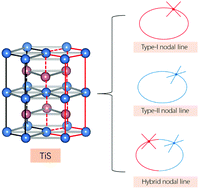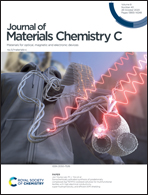Centrosymmetric TiS as a novel topological electronic material with coexisting type-I, type-II and hybrid nodal line states†
Abstract
Type-I, type-II and hybrid nodal lines show distinct electronic characteristics and have potential applications in electronic devices. However, it is still a challenge to explore a topological electronic material that naturally holds all these types of nodal lines simultaneously. Herein, we report for the first time that the centrosymmetric compound TiS is a novel topological material, with coexisting type-I, type-II and hybrid nodal lines in the low-energy band structure without spin–orbit coupling (SOC). These nodal lines are situated in the kz = 0 plane, and share the same symmetry-protection mechanisms. All the nodal lines show clear drumhead surface states, which can be detected experimentally. Besides the nodal lines, without considering SOC, TiS also shows a pair of symmetry-protected type-II Dirac points near the Fermi level, characterized by nontrivial Fermi arcs on the surface. After SOC is included, the Dirac points split into two pairs of type-II Dirac points, and the nodal lines open small gaps. The SOC gaps of nodal lines are smaller than or comparable with those of previous nodal line materials. These results suggest that the TiS compound is an excellent material to study the novel properties of nodal lines with type-I, type-II, and hybrid band dispersions, as well as the type-II Dirac points.



 Please wait while we load your content...
Please wait while we load your content...